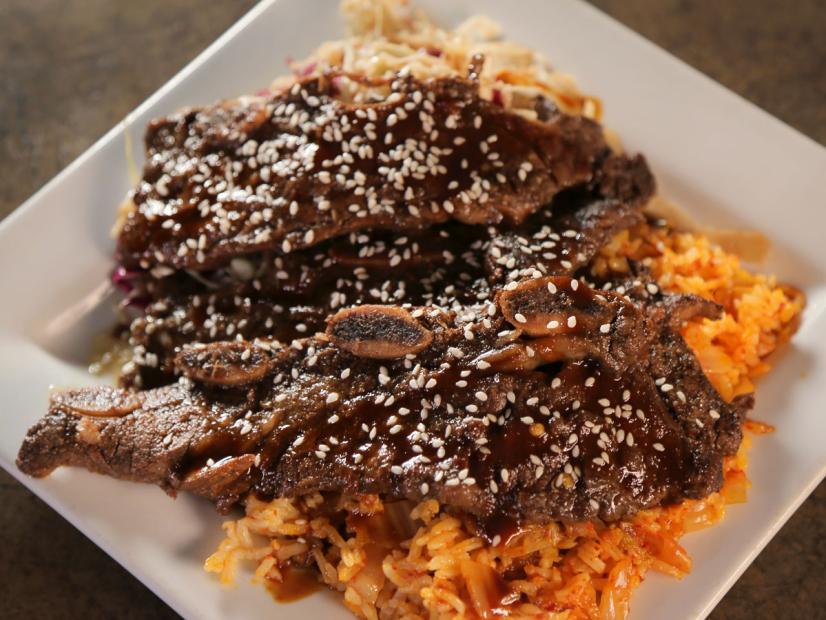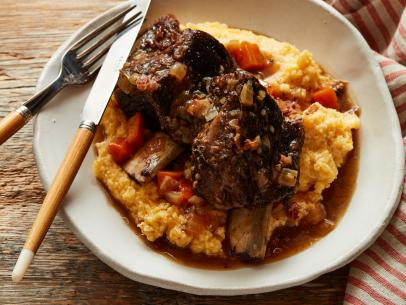
V's Slow-Braised Korean Short Ribs with Caramelized Kimchi Rice and Korean Cabbage Slaw
- Level: Intermediate
- Total: 2 hr
- Active: 1 hr 20 min
- Yield: 4 servings
- Level: Intermediate
- Total: 2 hr
- Active: 1 hr 20 min
- Yield: 4 servings
Ingredients
Bulgogi Marinade:
Kimchi:
Directions
- For the ribs: Preheat the oven to 400 degrees F.
- In a medium bowl, whisk together 3/4 cup canola oil, rice wine vinegar, soy sauce and chili-garlic paste to make a vinaigrette. Measure out 1/3 cup of the mixture and set aside, reserving for later. Add Bulgogi Marinade, sesame oil, and salt to the bowl; whisk to combine. Place ribs in a 9-by-13-inch pan, in two even layers. Pour sauce over ribs, shuffling the ribs around to ensure the sauce coats every side of every rib. Cover the pan securely with foil. Bake the ribs until the meat is tender and almost falling off the bone, about 1 hour and 20 minutes. To check ribs for doneness, lift corner of the foil and plastic wrap and use a fork to try to pick up a rib. If the meat is not yet done, replace plastic wrap and foil and place ribs back in oven for an additional 15 minutes. Remove ribs from oven.
- For the sides: Chop the kimchi into 1/2-inch pieces. Heat a large saute pan over medium-high heat; add the remaining 2 tablespoons canola oil. Add the butter and kimchi to the pan. Stir until the kimchi is caramelized and turns golden brown, about 5 minutes. Add the rice and stir well to combine. Cook until the rice fully absorbs the liquid from the kimchi and the flavors are incorporated, about 5 to 8 minutes. Add salt to taste. Remove from heat. Place the green and red cabbage in a medium bowl. Pour the reserved 1/3 cup vinaigrette over the cabbage and toss to coat.
- Divide the kimchi rice equally among four plates, placing it in a pile on one side of each plate. Do the same with the cabbage slaw, placing it next to the kimchi rice on each plate. Using a large spatula, gently remove ribs from the pan and place 3 ribs on top of the rice and slaw. Sprinkle with sesame seeds if using.
Bulgogi Marinade:
- Place soy sauce, brown sugar, sesame oil, garlic, ginger, green onions, onion, pear, apple, and mirin in a blender and blend until pulpy but not liquified. Refrigerate in an airtight container until ready to use.
Kimchi:
- Use a knife to slit the bottom of each cabbage an inch into the base. Set knife aside. With your hands, rip each cabbage in half lengthwise. Submerge the cabbage halves in water for 15 minutes. While cabbage soaks, put the 2 cups water and flour into a pan on the stove on high heat; bring to a boil, stirring constantly. When water reaches a boil, reduce heat to medium and simmer until the liquid coats the spoon, about 10 to 15 minutes. Remove from heat and stir in brown sugar. Set aside to cool.
- Remove cabbage from water, and shake off any excess water; place cabbage in a large bowl. Sprinkle and massage salt into each individual cabbage leaf. Let sit for 1 hour, turning cabbage every 15 minutes. Pour the cooled flour mixture into a blender. Add the oyster sauce, garlic cloves and ginger; blend until smooth. Pour into a bowl and stir in the gochujaro, daikon radish, and green onions. Rinse the cabbage in the sink to remove salt, and squeeze or shake out any excess water. Rinse bowl and return cabbage to the bowl. Using gloves (repeat: using gloves), massage paste in between each cabbage leaf. After working paste into each half of cabbage, place cabbage into a prepared kimchi vessel and press it down to the bottom as far as it will go. When all the cabbage is in the vessel, add any remaining paste to top of the cabbage. Make sure there is a weight to keep the cabbage below the level of the liquid. Replace lid or close bag, whichever is needed for the type of vessel being used; be sure there is ability for air to escape. Place a baking sheet underneath kimchi vessel before storing it to catch any liquid that may overflow during the fermentation process. Store kimchi container in a dark, out-of-the-way place at room temperature for 24 hours. Check after 12 hours to make sure cabbage is submerged in the liquid; if not, press cabbage down into the liquid.
- After 24 hours, place kimchi container in the refrigerator. Let kimchi sit for a minimum of 7 days before eating, checking and pressing down every 3 days. The longer the kimchi is allowed to sit and ferment, the stronger the flavor; the sweet spot is around 20 days.
- Note: There are a variety of vessels you can use to make kimchi. You can use a traditional earthenware jar, food-safe bucket, or even a large bowl or food storage container. Make sure your vessel is large enough to have room at the top for the fermentation process to happen. I suggest a clean black garbage bag as a liner to any container you use so it creates a dark environment, and it’s easy to check because you can unwrap and retie it easily. For your weight, use anything heavy that fits inside the top of the container; I use a brick wrapped in foil.
Cook’s Note
Use any extra (or make a double batch!) of the bulgogi marinade to marinate steaks, vegetables, or game meat
Looking for Something Else?
Related Pages
- Kalbi (Korean Barbequed Beef Short Ribs) Recipe
- Asian-Style Braised Short Ribs Recipe
- Slow Braised Beef Short Ribs Recipe
- Beef Short Rib Stew (Slow Cooker Kalbijjim) Recipe
- Braised Bison Short Ribs with Asian Slaw Recipe
- Instant Pot Korean Style Short Ribs Recipe
- Korean Short Rib Tacos Recipe
- Fried Chicken, Korean Style with Napa Cabbage...
- Korean-Inspired Braised Short Ribs Recipe
































